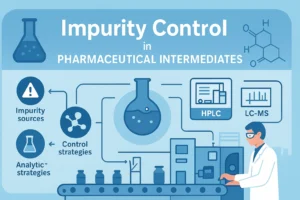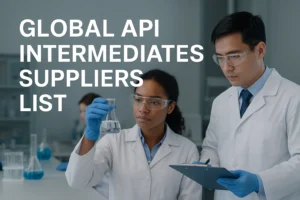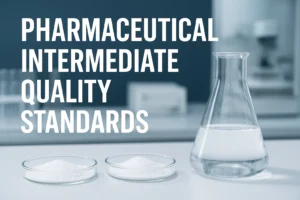Many people mistakenly believe that API manufacturing is simply “following the recipe.” In reality, every step requires scientific design and rigorous validation.
For example, when developing a synthetic route for an antiviral drug, neglecting to control the cooling rate during the crystallization of an intermediate could result in non-uniform crystal forms, necessitating reprocessing of the entire batch.
Synthesis Route Selection and Optimization: How to Balance Efficiency and Purification?
The selection of a synthetic route is the starting point of the active pharmaceutical ingredient (API) manufacturing process, directly impacting cost, environmental performance, and quality control. We typically evaluate routes based on the following dimensions:
- Atom Economy: Prefer routes with fewer steps and higher yields to minimize waste generation;
- Impurity Profile Control: Avoiding the use of reagents or solvents that are prone to generating genotoxic impurities (GTIs);
- Process Robustness: Selecting reaction conditions with a wide operating window and easily controllable parameters.
Taking the synthesis of a certain antidiabetic API as an example, the initial route required eight steps and yielded less than 30%. Through route optimization, we employed a key chiral catalytic step, reducing the number of steps to five, increasing the yield to 65%, and avoiding the use of highly hazardous reagents.
Lessons learned: Route optimization isn’t simply about pursuing “fewer steps” but rather requires a comprehensive consideration of raw material availability, purification difficulty, and plant equipment compatibility.
Detailed Explanation of Key Unit Operations: Chemical Reactions Are Only Part of the Manufacturing Process
The manufacturing process of active pharmaceutical ingredients (APIs) involves multiple unit operations, the following of which are particularly critical:
1、Reaction Engineering Control
Parameters such as temperature, pH, addition sequence, and rate must be precisely controlled to prevent side reactions.
For highly exothermic reactions (such as nitration and hydrogenation), a reliable cooling system and emergency pressure relief devices are essential.
2、Separation and Purification Technologies
- Crystallization: Achieve the desired crystal form and particle size distribution by manipulating the solvent system, cooling profile, and stirring rate.
- Extraction: Select the appropriate solvent ratio and extraction times to improve product yield.
- Chromatographic Purification: Although costly, it is an effective method for chiral separation or removal of complex impurities.
3、Drying and Packaging
The drying method (tray drying, fluidized bed drying, vacuum drying) affects the residual solvent and powder properties of the API.
The packaging environment requires strict control of temperature, humidity, and cleanliness to prevent degradation and contamination.
Quality Control Throughout: From Starting Materials to Finished Product Release
In the active pharmaceutical ingredient (API) manufacturing process, quality is not just the final checkpoint; it’s a system integrated into every step:
- Starting Material Control: Establish a supplier audit mechanism to ensure that raw material purity and impurity profiles meet standards;
- Process Analytical Technology (PAT): Use online monitoring (e.g., NIR, Raman) to adjust process parameters in real time;
- Impurity Profile Studies: Identify process and degradation impurities and assess their toxicity (e.g., in accordance with ICH M7);
- Stability Studies: Determine the storage conditions and shelf life of the API through accelerated and long-term testing.
We once encountered a problem with a batch of API with a decreased content. Ultimately, by tracing the impurity profile of the intermediate, we discovered that residual metal ions in a starting material catalyzed the oxidation reaction. Since then, we have strengthened our control of the metal content in starting materials.
cGMP and Compliance Requirements: A Passport to Global Production
The manufacturing process for active pharmaceutical ingredients (APIs) must comply with international cGMP standards. Key points include:
- Documentation: Completely record all data from development to production to ensure traceability;
- Change Control: Any changes to processes, equipment, or materials must be fully validated and documented;
- Cleaning Validation: Prevent cross-contamination, especially for high-potency APIs (HPAPIs);
- Data Integrity: Ensure that electronic records are authentic, accurate, and auditable.
In recent years, agencies such as the FDA and EMA have increasingly stringently scrutinized data authenticity. The deployment of automated systems and audit tracking capabilities can significantly enhance data credibility.
Future Trends: Continuous Flow Manufacturing, Green Processes, and Digital Empowerment
The manufacturing process for active pharmaceutical ingredients (APIs) is undergoing technological innovation:
- Continuous Flow Manufacturing: Shortens production cycles and improves process control precision, especially for high-risk reactions;
- Green Chemistry: Develops sustainable processes such as low-toxic solvent substitution and catalytic reactions;
- Digitalization and AI: Leverages machine learning to optimize process parameters and predict impurity generation trends.
Conclusion: The Manufacturing Process is the Core Assurance of API Quality
The manufacturing process of active pharmaceutical ingredients (APIs) is a balancing act—striving for optimal solutions between chemistry, engineering, and quality. As practitioners, we must understand reaction mechanisms, be familiar with equipment characteristics, and establish a systematic approach to quality. Only in this way can we consistently provide safe, effective, and stable API products.
We (Tianming Pharmaceuticals) specialize in process development and commercial production of highly complex APIs, with comprehensive capabilities from laboratory research to factory scale-up.
Behind every batch of API lies a commitment to meticulous manufacturing processes—for sample testing, technical exchanges, and customized services, please contact us at sunqian0123@gmail.com



